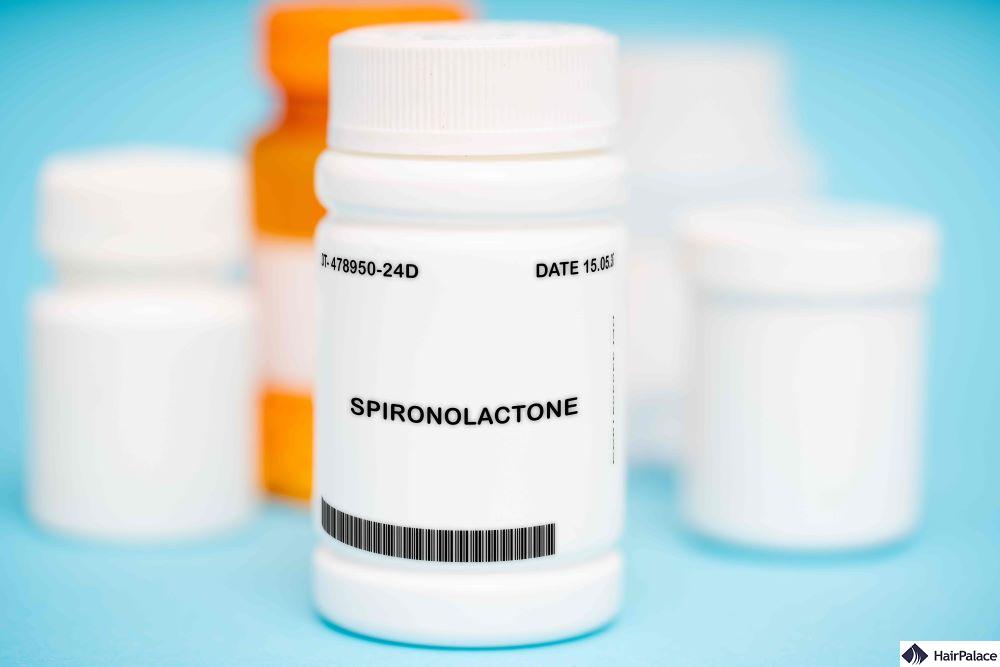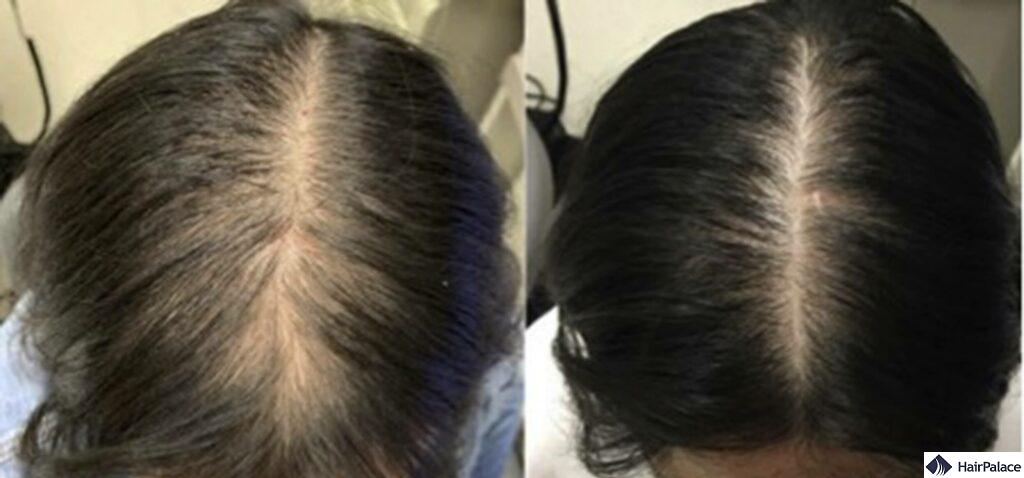Spironolactone for Hair Loss: Benefits and Efficacy

Spironolactone treats fluid retention and high blood pressure, and many clinicians also use it to manage hormone-related hair loss.
By reducing the effects of androgens on hair follicles, spironolactone can help slow shedding.
It may also improve hair density, particularly in women experiencing androgenic alopecia or hormonal imbalances.
Although the FDA hasn’t approved spironolactone specifically for hair loss, doctors frequently prescribe it off-label, and researchers continue to study it as a promising option.
It’s typically recommended where other treatments may not be effective or well-tolerated for women experiencing female pattern baldness.
- What is spironolactone?
- How does spironolactone hair loss treatment work?
- Spironolactone dosage for hair loss
- Spironolactone vs finasteride for male hair loss
- Spironolactone for hair loss benefits
- Spironolactone hair loss before and after
- Spironolactone for hair loss side effects
- Alternatives to spironolactone for hair loss

What is spironolactone?
Spironolactone is a potassium-sparing diuretic (water pill) that works by blocking the effects of the hormone aldosterone in the kidneys.
Because spironolactone helps the body excrete excess sodium and water while retaining potassium, clinicians often prescribe it for high blood pressure, heart failure, liver cirrhosis, and oedema.
Beyond its diuretic effect, spironolactone also acts as an anti-androgen.
It blocks androgen receptors and reduces the production and activity of male hormones, such as testosterone.
Because of this, doctors often prescribe it off-label for conditions influenced by hormones, such as female pattern hair loss, acne, and hirsutism.
How does spironolactone hair loss treatment work?
Many cases of hair loss in women are linked to the activity of androgens.
These can shrink hair follicles, shorten the growth phase, and ultimately lead to hormonal hair loss.
Here’s how taking spironolactone treatment of female pattern hair loss works against that process:
- Blocks androgen receptors: It prevents DHT and testosterone from binding to receptors in hair follicles.
- Reduces androgen production: It decreases overall testosterone levels by affecting hormone balance.
- Protects hair follicles: By lowering the impact of androgens, it slows follicle miniaturisation and helps maintain thicker, healthier hair.
Because of this dual action, spironolactone therapy is often prescribed off-label for women suffering from female pattern baldness, especially when signs of hormonal influence are also present.
Spironolactone dosage for hair loss
Clinicians most often prescribe spironolactone 50–200 mg daily to women for hair loss, adjusting the dose based on tolerance and response.
In most cases, it’s recommended only when other hair loss treatments fail to produce improvement.
Lower doses may be used at the start to reduce side effects, with gradual increases as needed to optimise hair regrowth.
In men, oral spironolactone is generally not recommended because the anti-androgenic effects can cause unwanted side effects such as gynecomastia and sexual dysfunction.
Oral and topical spironolactone treatment have differences in terms of adverse events reported by patients.
So topical formulations at much lower concentrations are being studied as a potential alternative with fewer systemic effects.
Spironolactone vs finasteride for male hair loss
Two medications often discussed in the context of treating hair loss are finasteride and spironolactone, both of which act on androgen pathways but in very different ways.
Doctors typically prescribe finasteride to men because exposure during pregnancy can cause birth defects, while they treat women’s hair loss with spironolactone.
Finasteride
Finasteride is a 5-alpha reductase inhibitor that reduces the conversion of testosterone into DHT, the hormone primarily responsible for shrinking hair follicles in male pattern baldness.
The FDA approved finasteride for treating male hair loss, and extensive clinical evidence shows it can slow thinning and even promote regrowth in some cases.
Men typically take finasteride 1 mg once daily; most tolerate it well, though some experience reduced libido, erectile dysfunction, or gynecomastia.
Because of its targeted action and regulatory approval, finasteride remains the standard medical treatment for male pattern baldness.
Spironolactone
Spironolactone, on the other hand, is primarily a potassium-sparing diuretic with strong anti-androgenic properties.
It works by blocking androgen receptors and reducing testosterone activity, which can help in conditions like female androgenetic alopecia.
However, in men, its use is highly limited due to the systemic side effects we discussed earlier.
Clinicians do not recommend spironolactone for male hair loss, and the FDA has not approved it for this use.
Spironolactone for hair loss benefits
It can be beneficial for hair loss because of its anti-androgenic effects.
Blocking androgen receptors and lowering the impact of hormones like testosterone and dihydrotestosterone (DHT), helps reduce the miniaturisation of hair follicles that leads to thinning.
This makes it especially effective in women with androgenetic alopecia.
Additionally, it may also regulate hormone fluctuations that contribute to shedding, particularly in women with conditions like polycystic ovary syndrome (PCOS).
Many patients also report a slowdown in shedding and, over time, improved hair density.
Spironolactone hair loss before and after

Spironolactone for hair loss side effects
The drug can help with hair loss, but it also carries a risk of side effects because of its hormone-blocking activity.
Common ones include dizziness, fatigue, breast tenderness, irregular menstrual cycles (in women), and increased urination since it’s also a diuretic.
More significant side effects may involve low blood pressure, high potassium levels, decreased libido, and breast enlargement.
Because of these risks, spironolactone is usually prescribed for women and monitored with regular blood tests, while its oral use in men is generally avoided.
In men, spironolactone is rarely used because it may cause gynecomastia, reduced libido, and erectile dysfunction.
Topical forms may offer fewer systemic side effects, but research on their long-term safety is still limited.
Does spironolactone cause hair loss?
Spironolactone does not cause hair loss. However, some patients experience a phase of increased shedding early on.
Clinicians consider this a temporary adjustment: weaker hairs shed and make way for stronger regrowth.
Over time, spironolactone can help stabilise the hair cycle, reducing ongoing loss and supporting thicker, healthier strands.

Alternatives to spironolactone for hair loss
We’ve already covered finasteride, the most commonly prescribed alternative to spironolactone, though it is only suited for men.
For women seeking options, there are several other effective treatments worth considering:
Minoxidil
Minoxidil is a topical treatment available over the counter in foam or liquid form.
It increases blood flow to the scalp and prolongs the growth phase of the hair cycle, which helps stimulate new hair growth and reduce shedding.
It is FDA-approved for both men and women, though results vary and continuous use is needed to maintain improvements.
Low-level laser therapy
Laser caps, combs, or helmets use low-level red light to stimulate follicle activity and improve hair density.
While not as extensively studied as finasteride or minoxidil, clinical trials suggest it can be a safe, noninvasive option, particularly when combined with other treatments.
Platelet-rich plasma therapy
PRP involves drawing a patient’s blood, processing it to concentrate the platelets, and injecting it into the scalp.
The growth factors in platelets can stimulate follicles and promote thicker, healthier hair.
It requires multiple sessions and is considered safe, but availability and cost can be limiting factors.
Hair transplant surgery
For more advanced hair loss, surgical options such as follicular unit extraction (FUE) or follicular unit transplantation (FUT) can provide permanent results.
These procedures relocate healthy follicles from the donor area to thinning regions, restoring a natural-looking hairline and density.
FAQ
50 mg of spironolactone is often considered a starting dose for hair loss, but effectiveness varies, and some people may need higher doses under medical supervision. Always consult a doctor before adjusting dosage.
Last medically reviewed on September 29th, 2025
- Skluth HA, Gums JG. Spironolactone: a re-examination. DICP. 1990 Jan;24(1):52-9. doi: 10.1177/106002809002400112. PMID: 2405587.https://pubmed.ncbi.nlm.nih.gov/2405587/
- Kow CS, Ramachandram DS, Hasan SS, Thiruchelvam K. Spironolactone for the Treatment of Moderate to Severe Acne in Adult Women: A Systematic Review and Meta-Analysis of Randomised Controlled Trials. Australas J Dermatol. 2025 May;66(3):165-168. doi: 10.1111/ajd.14428. Epub 2025 Feb 6. PMID: 39912292.https://pubmed.ncbi.nlm.nih.gov/39912292/
- Searle TN, Al-Niaimi F, Ali FR. Spironolactone in dermatology: uses in acne and beyond. Clin Exp Dermatol. 2020 Dec;45(8):986-993. doi: 10.1111/ced.14340. Epub 2020 Aug 26. PMID: 32844462.https://pubmed.ncbi.nlm.nih.gov/32844462/
- Ntshingila S, Oputu O, Arowolo AT, Khumalo NP. Androgenetic alopecia: An update. JAAD Int. 2023 Jul 22;13:150-158. doi: 10.1016/j.jdin.2023.07.005. PMID: 37823040; PMCID: PMC10562178.https://pubmed.ncbi.nlm.nih.gov/37823040/


